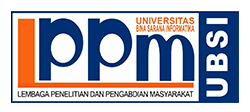Perilaku Minat Wisatawan Terhadap Ekowisata Hutan Mangrove Baros Bantul
Sari
Keywords: Ecotourism Tourist Visits, Interests, Visitors, Baros Bantul Mangrove Ecotourism
Abstrak – Tujuan penelitian ini adalah untuk mengetahui perilaku minat wisatawan yang mengunjungi tujuan Ekowisata Hutan Mangrove Baros Bantul. Untuk tujuan ini, survei lapangan telah dilakukan di Ekowisata Hutan Mangrove Baros Bantul sebagai pusat ekowisata Hutan Mangrove di Bantul . Survei diterima dari 100 peserta yang terdiri atas wisatawan yang berkunjung ke Ekowisata Hutan Mangrove Baros Bantul . Setelah analisis, dilakukan penilaian tentang minat wisatawan di daerah tersebut. Temuan penelitian Perlunya mengembangkan program kegiatan pengembangan yang menggabungkan potensi alam dan budaya untuk ;lebih menarik minat kunjungan wisatawan. Mengenalkan dan mempromosikan potensi wisata Mangrove Baros, Pengembangan sarana dan prasarana, Peningkatan kemampuan SDM masyarakat lokal dalam pelatihan manajerial dan pelatihan teknis penyambutan wisatawan serta Pebaikan akses menuju ke Wisata Mangrove Baros Bantul
Kata kunci: Perilaku Kunjungan Wisatawan Ekowisata, Minat, Pengunjung, Ekowisata Hutan Mangrove Baros Bantul
Teks Lengkap:
PDFReferensi
Albayrak, T., Aksoy, S., and Caber, M. 2013. The effect of environmental concern and scepticism on green visit behaviour. Marketing Intelligence and Planning, Vol 31 No 1, pp 27 - 39.
Ali, A., Khan, A. A., Ahmed, I., and Shahzad, W. 2011. Determinants of Pakistani Consumers’ Green Visit Behavior: Some Insights. International Journal of Business and Social Science, Vol 2 No 3, pp 217-226.
Alibeli, M., and Johnson, C. 2009. Environmental Concern: A Cross National Analysis. Journal ofInternational and cross-cultural studies, Vol 3 No 1, 1-10.
Aman, L., Harun, A., and Hussein, Z. 2012. The Influence of Environmental Knowledge and Concern on Green Visit Intention the Role of Attitude as a Mediating Variable. British Journal of Arts and Social Sciences, Vol 7 No 2, pp145-167.
Arnau, R. C., and Thompson, B. 2000. Second order confirmatory factor analysis of the WAIS- III. Assessment. Vol 7 No 3, pp 237-246.
Anderson, J. C. and Gerbing, D. W. 1988. Structural equation modeling in practice: a review and recommended two-step approach. Psychological Bulletin. Vol 103 No 3, pp 411-423.
Bamberg, S., 2003. How does environmental concern influence specific environ¬mentally related behaviors? A new answer to an old question. Journal of Environmental Psychology. Vol 23 No1, pp 21–32.
Bandalos, D. L. 2002. The effects of item parceling on goodness-of-fit and parameter estimate bias in structural equation modeling. Structural Equation Modeling. Vol 9 No 1, pp 78-102
Becker, J. M., Rai, A., Ringle, C. M., and Völckner, F. 2013. Discovering unobserved heterogeneity in structural equation models to avert validity threats. Mis Quarterly. Vol 37 No 3, pp 665-694.
Budeanu, A., 2007. Sustainable tourist behaviour – a discussion of opportunities for change. International Journal of Consumer Studies Vol 31 No 5, pp 499–508.
Chang, J.E., Cheng, L., 2011. Evolution and prospect of environmental technology. Science Development Vol 45 No 7, 103–108.
Chen YS, Lai SB, Wen CT. 2006. The influence of green innovation per¬formance on corporate advantage in Taiwan. Journal of Business Ethics. Vol 67 No 4, pp 331-339.
Chin, C., Moore, S. and Wallington, T. 2000. National Eco-tourism: Visitors’ Perspectives on Environmental Impacts and their Management. Journal Sustainability Tourism. Vol 8 No 1, pp 20-35.
Farrell, T. and Marion, J. 2001. Identifying and assessing ecotourism visitor impacts at eight protected areas in Costa Rica and Belize. Environmental Conservation. Vol 28 No 3, pp 215–225.
Flamm, B., 2009. The impacts of environmental knowledge and attitudes on vehicle ownership and use. Transportation Research Part D: Transport and Environment Vol 14 No 4, pp 272–279.
Gilg A, Barr S, Ford N. 2005. Green consumption or sustainable lifestyles? Identifying the sustainable consumer. Futures. Vol 37 No 6 pp 481–504.
Hair, J. F., Black, W.C., Babin, B. J., Anderson, R. E., and Tatham, R. L. 2005. Multivariate data analysis 6th. Upper Saddle River, New Jersey: Pearson Prentice Hall.
Hair, J. F., Sarstedt, M., Hopkins, L., and Kuppelwieser, G.V. 2014. Partial least squares structural equation modeling: An emerging tool in business research. European Business Review. Vol 26 No 2, pp 106-121.
Han, H., Hsu, L.-T., Lee, J.S., 2009. Empirical investigation of the roles of attitudes towards green behaviors, overall image, gender, and age in hotel customers’ eco-friendly decision-making process. International Journal of Hospitality Man¬agement. Vol 28, pp 519–528.
Hasan, A., Subhani, Imtiaz, M., Osman, and Amber. 2011. The crux of green marketing: an empirical effusive study. European Journal of Social Science, Vol 27 No 3, 425-435.
Hox, J.J and Bechger, T.M. 1998, An Introduction to Structural Equation Modeling. Family Science Review. Vol 11, pp 354-373.
Hu, L., and Bentler, P. M. 1999. Cutoff criteria for fit indexes in covariance structure analysis: conventional criteria versus new alternative. Structural Equation Modeling. Vol 6 No 1, pp 1-55.
Kahn, M.E., 2007. Do greens drive hummers or hybrids? Environmental ideology as a determinant of consumer choice. Journal of Environmental Economics and Management. Vol 54 No 2, pp 129–145.
Kim Y, Choi SM. 2005. Antecedents of green purchase behavior: An examination of collectivism, eco-tourism concern, and perception consumer. Advances in Consumer Research. Vol 32, pp 592 - 607.
Kim, Y., Han, H., 2010. Intention to pay conventional-hotel prices at a green hotel-a modification of the theory of planned behavior. Journal of Sustainable Tourism Vol 18 No 8, pp 997–1014.
Klein, A. and Moosbrugger, H. 2000. Maximum likelihood estimation of latent interaction effects with the LMS method. Psychometrica. Vol 65 No 4, pp 457-474.
Kuminoff, N.V., Zhang, C., Rudi, J., 2010. Are travelers willing to pay a premium to stay at a “green” hotel? Evidence from an internal meta-analysis of hedonic price premia. Agricultural and Resource Economics Review Vol 39 No 3, pp 468–484.
Lafuente R. 2010. Defining and measuring eco-tourism conscious¬ness. International Journal of the Sociological Science. Vol 68 No 3, pp 731–755.
Lee, J.-S., Hsu, Jane, L.-T., Han, H., Kim, Y., 2010. Understanding how consumers view green: how a green image can influence behavioural intentions. Journal of Sustainable Tourism Vol 18 No 7, pp 901–914.
Lee, K. 2009. Gender differences in Hong Kong adolescent consumers' green intention behavior. Journal of Consumer Marketing, Vol 26 No 2, pp 87-96.
Liu, X., Wang, C., Shishime, T., Fujitsuka, T., 2012. Sustainable consumption: green purchasing behaviours of urban residents in China. Sustainable Development. Vol 20 No 4, pp 293–308.
Manaktola, K., Jauhari, V., 2007. Exploring consumer attitude and behaviour towards green practices in the hotel accommodation industry in India. International Journal of Contemporary Hospitality Management Vol 19 No 5, pp 364–377.
Marion, J.L. and Leung, Y. 2001. Trail resource impacts and an examination of alternative assessment techniques. Journal of park and Recreation Administration, Vol 19 No 3, pp 17– 37.
Mei, O. J., Ling, K. C., and Piew, T. H. 2012. The Antecedents of Green Visit Intention among Malaysian Consumers. Asian Social Science, Vol 8 No 13, pp 248-263.
Noar, S. M. 2003. The role of structural equation modeling in scale development. Structural Equation Modeling. Vol 10 No 4, pp 622-647.
Paco, A., Rapose, M., 2009. “Green” segmentation: an application to the Portuguese consumer market. Marketing Intelligence and Planning Vol 27 No 3, pp 364–379.
Papageorgiou, K. and Vogiatzakis, I. 2006. Nature protection in Greece: an appraisal of the factors shaping integrative conservation and policy effectiveness. Environment Science. Policy, Vol 9 No 5, pp 476–486.
Rahbar, E., and Wahid, N. A. 2011. Investigation of green marketing tools' effect on consumers' visit behavior. Business Strategy Series, Vol 12 No 2, 73 - 83.
Ramayah, Lee, J. W., and Mohamad, O. 2010. Green product visit intention: Some insights from a developing country. Resources, Conservation and Recycling, Vol 54 No 12, pp 1419–1427.
Rashid, N. R. 2009. Awareness of Eco-label in Malaysia’s Green Marketing Initiative. International Journal of Business and Management, Vol 4 No 8, pp 132-141.
Schermelleh-Engel, K., Moosbrugger, H., and Müller, H. 2003. Evaluating the fit of structural equation models: Tests of significance and descriptive goodness-of-fit measures. Methods of Psychological Research Online. Vol 8 No 2, pp 23–74.
Sharma N, Sharma CS. 2014. Studying green purchasing intentions through eco-tourism motivation. Proceeding of Contemporary Management Practices Opportunities and Challenges. 323–328.
Sharma N, Sharma CS. 2013. Encouraging green purchasing behavior through green branding. Business Analyst. Vol 34 No 2 pp 65–76.
Sihar Tambun, 2014. Metode SEM dan Interpretasi Hasil Penelitian Dengan Menggunakan AMOS. Pelatihan SEM dengan AMOS. http://dosen.uta45jakarta.ac.id. Akses 15 April 2017
Spanou, S. Tsegenidi, K. and Georgiadis, T. 2012. Perception of Visitors’ Environmental Impacts of Ecotourism, Intrternational Journal Environment Responsibility., Vol 6 No 1, pp 245-258.
Soemarno, 2011. Metode Penelitian : Structural Equation Modelling http://marno. lecture.ub.ac.id. Akses 15 April 2017
Vermeir I, Verbeke W. 2006. Sustainable food consumption: Exploring the consumer attitude–behavioral intention gap. Journal of Agricultural and Environmental Ethics. Vol 19 No 2, pp 169–94.
Yazdanifard, R., and Mercy, I. E. 2011. The impact of Green Marketing on Customer satisfaction and Environmental safety. International Computer Communication and Management, Vol 5, pp 637-64
DOI: https://doi.org/10.31294/khi.v10i1.5622
====================================================================
Terbit setiap bulan Maret & September, ISSN : 2655-5433 (online)













